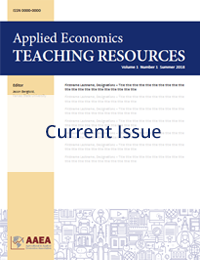Teaching Education Commentary
Engaging Students in Open Dialogue about Use of AI Tools in Economics Courses
Zoë Plakias(a)
(a)Western Washington University
JEL Codes: JEL Codes: A22, O33
Keywords: Dialogue, conversation, student engagement, policy
First Published Online: December 11, 2024
Abstract
The rapid expansion of artificial intelligence (AI) tools is a scary prospect for many of us in college teaching roles. But these tools are here to stay. After my own initial resistance to AI tools in the classroom, I decided to engage each of my classes in conversation about them. In this commentary, I describe my experience with engaging my undergraduate classes in open dialogue about the use of AI and developing a collective agreement about how AI tools can be used in the classroom. While some faculty may not be ready to use AI tools themselves for assignments and classroom activities, facilitating conversations with students about these tools is an easy and low-cost way to explore the use of AI tools in the classroom and develop reasonable, fair, and clear policies for classroom use. Working collaboratively with our students to determine the best use of AI, as these tools evolve, is vital to ensuring these tools enhance rather than detract from students’ educational experience, as well as contribute to a culture of trust and respect that students value.
References
Hooks, b. 1994. Teaching to Transgress: Education as the Practice of Freedom. New York: Routledge.
Kelly, K. 2010. What Technology Wants. New York: Viking.
Lang, J.M. 2013. Cheating Lessons: Learning From Academic Dishonesty. Cambridge MA: Harvard University Press.
Shear, H.E., L.L. Britton, K. Aleks Schaefer, B. Thapa, and J.S. Bergtold. 2023. “Artificial Intelligence and the Future of Learning and Assessment in Agricultural and Applied Economics.” Journal of the Agricultural and Applied Economics Association 2(4):838–850.
Articles in this issue
Textbook Review of: Equilibrium Displacement Models: Theory, Applications, and Policy Analysis. By Gary W. Brester, Joseph A. Atwood, and Michael A. Boland
George Davis, Andrew Keller, Henry Kinnucan, Mike McCullough, Hikaru Hanawa Peterson, et al.
Reflecting on Using Reflection Exercises to Improve Student Learning and Teaching Effectiveness
Jaclyn D. Kropp
Innovate to Lead: Curriculum Innovations to Meet Students’ Needs in Applied Agricultural Economics and Agribusiness Programs
Rachna Tewari , Na Zuo, Maria Bampasidou, Anthony Delmond, Lijiao Hu, Tanner McCarty, et al.
Using NetLogo to Build an Agent-Based Model for Teaching Purposes at the Graduate Student Level
Bryan Collins and Chyi-Lyi (Kathleen) Liang
An Ignatian Pedagogical Approach to Fostering Conversations on BIPOC Farmland Ownership Through Film Screenings
Jacquelyn D. Wiersma-Mosley, Trey Malone, Logan G. Moss, and Wendell Scales Jr.
Using Generative Artificial Intelligence to Aid Classroom Retention
J. Ross Pruitt, Anthony R. Delmond, Sandy Mehlhorn, and Diana L. Watson
Engaging Students in Open Dialogue about Use of AI Tools in Economics Courses
Zoë Plakias
Farmland Price-Rent Surveys: Opportunities for Outreach and Teaching
B. James Deaton, Nicholas Bannon, Alexander Scholz, and Jamie Naylor


